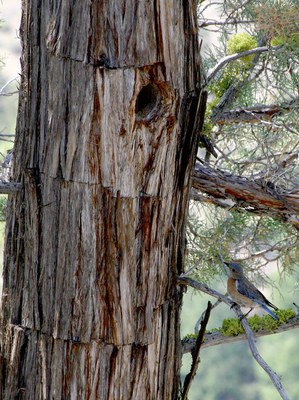Western junipers can be found throughout Central Oregon and are an iconic tree in our forests and grasslands. But sometimes junipers get a bad rap. They grow abundantly in places where they didn’t before, and that disrupts the balance of animal and plant life that keeps Central Oregon’s natural areas healthy. But it’s important to remember that juniper is native even if it has become invasive in some parts of our region.

Not Just A Weed
Historically, junipers thrived in higher-elevation rocky soils that are inhospitable to many other native plants, while saplings that took root in lower elevations would be contained by periodic fire. Old-growth juniper trees can live for more than a thousand years, and provide incredible value in terms of habitat, climate records, and genetic diversity.
These trees are rot-resistant, provide shelter for cavity nesting birds like the Northern flicker and the juniper titmouse, and see repeated use by these birds season after season. For overwintering birds, junipers provide needed shelter and food. Small stands of juniper also reduce temperature severity, wind, and snow cover during the winter and provide shelter for deer fawns, leading to higher survival rates.
Invaders arrive
Beginning in the 1870s, changes in land use and management, including grazing and fire suppression, depleted the native grasses that dominated Central and Eastern Oregon, leaving room for junipers to flourish and become more invasive. Junipers excel at outcompeting native grasses, shrubs, and wildflowers for nutrients, water, and sunlight.
This increase in junipers dramatically decreased habitat quality for multiple species. Populations of Central Oregon’s iconic greater sage-grouse have dropped an estimated 80% due to habitat loss, and other songbirds have lost critical nesting areas. Bighorn sheep and pronghorn antelope may become more vulnerable to mountain lion predation where juniper stands break up their line of sight on the horizon. Juniper woodlands can also decrease the forage for cattle grazing by 30 to 90 percent.
There’s also evidence that large numbers of juniper trees may impact our access to water. The ongoing Camp Creek Paired Watershed Study in the Crooked River watershed southeast of Prineville has found an increase in soil moisture, groundwater, and spring flow in test areas where large numbers of juniper have been cut.
What the Land Trust is Doing
Research has shown that grasses and shrubs can come back after juniper is removed from places it did not historically flourish. Reducing juniper stands to around 10-15 trees per acre allows light and rainfall to reach grasses, shrubs, and wildflowers. Juniper thinning also helps protect areas from severe fire impacts and improves habitat for animals. That’s why the Land Trust continues to thin juniper at our Preserves to help care for and restore these important habitats.
Sources:
- Getting to the Root of the Problem: Juniper Removal and Upland Restoration in Oregon, Oregon Explorer Natural Resources Library
- The Tree That Ate the West, biographic.com
- Managing Western Juniper for Wildlife, Woodland Fish and Wildlife Misc0286, Oregon Department of Fish and Wildlife
- Deschutes Land Trust Western Juniper Management Plan
Learn more:
- Trees to Know in Central Oregon
- Another Round of Juniper Thinning at Priday Ranch
- Our Restoration Work


